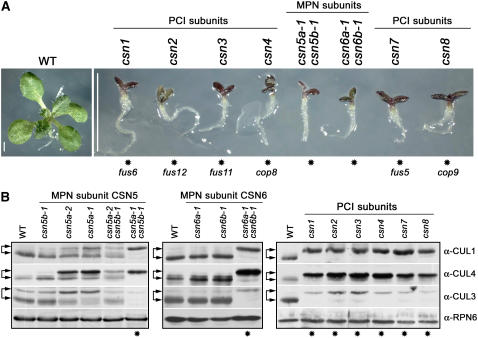Figure 7.
The Essential Role of the CSN in Cullin Derubylation as Well as the Maintenance of the Cellular Pools of CUL3 and CUL4.
(A) Phenotypes of 13-d-old white light–grown wild-type (left) and the set of eight csn complete loss-of-function mutant (right) seedlings, corresponding to each CSN subunit. The six PCI subunit mutants shown correspond to cop/det/fus mutants identified by genetic screens (see Methods), as indicated below the asterisks.
(B) Protein blot analyses of the wild type and csn5 single and double mutants (left panel), the wild type and csn6 single and double mutants (middle panel), or the wild type and the six PCI subunit mutants shown in (A) (right panel), as indicated. Equal amounts of total proteins extracted from 13-d-old white light–grown seedlings were subjected to SDS-PAGE and immunoblot analyses with anti (α)-CUL1, α-CUL4, and α-CUL3 polyclonal antibodies. α-CUL3 antibody recognizes both CUL3A and CUL3B isoforms. The α-RPN6 antibody was used as a loading control. Top arrows indicate rubylated CUL1, CUL4, and CUL3, respectively, and bottom arrows indicate the un-rubylated forms. The asterisks indicate the complete loss-of-function mutants.

